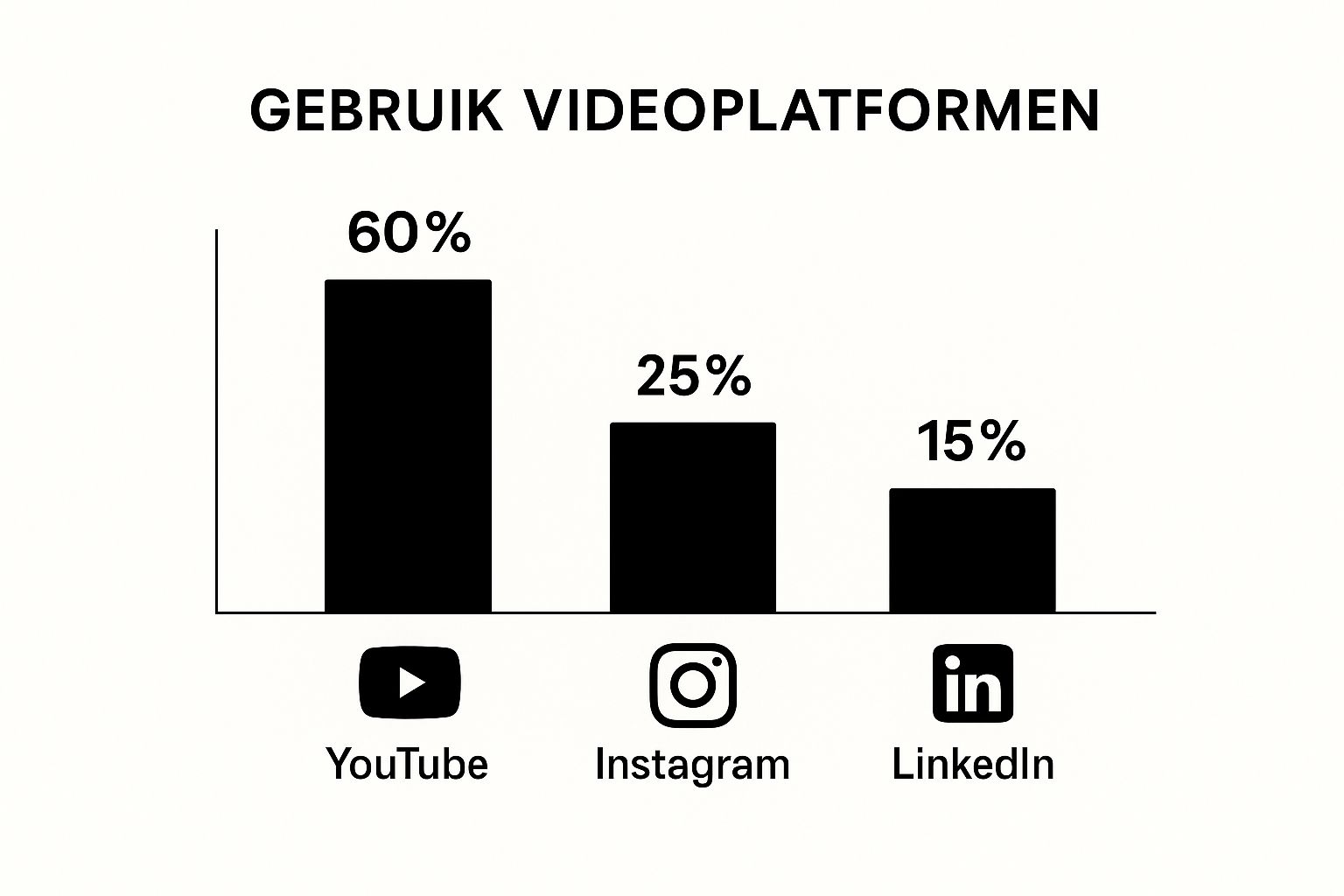Effective video marketing today is much more than just a nice bonus. It's the engine of a strong marketing strategy that helps brands truly break through. The days of static images are over; the focus is now firmly on dynamic, visual stories that we create together.
Why video is no longer an option in modern marketing

Video may have been a nice-to-have in the past, but today it's an indispensable tool in your strategy toolbox. The power of marketing and video It's the ability to convey complex messages quickly and sensitively. Unlike a block of text or a simple photo, video combines image, sound, and movement. This creates an experience that lingers much longer.
This psychological impact is directly reflected in your business results. Videos significantly increase visitor retention on your website, which search engines consider a very positive sign. More importantly, they build trust and give your brand a human face. This is crucial for forging lasting customer relationships.
From trend to norm
The use of video by companies has exploded in recent years. This isn't a fleeting fad, but a profound shift in how brands communicate. The figures for the Belgian market speak for themselves.
Recent data shows that by 2025 it is estimated that 91% of the companies video marketing will use. That's a huge leap compared to the 61% in 2016. This proves that video has become an integral part of the marketing mix. In fact, 93% of the marketers sees video as a crucial part of their strategy. Want to dive deeper into the numbers? Then this is overview of video marketing statistics highly recommended.
A video on your landing page can increase your conversion rates by more than 80%. It's one of the most effective ways to engage a visitor and encourage them to take action.
So the question is no longer or you need to use your video, but how you do that strategically to achieve your goals.
Take control to get ahead
In marketing, standing still means going backward. Companies that neglect video risk becoming irrelevant to an audience increasingly demanding visual content. A proactive approach is therefore essential.
That doesn't mean you just throw a video online every now and then. A successful strategy requires a well-thought-out plan perfectly tailored to your goals and target audience. Consider:
- Clear goals: Do you want to build brand awareness, collect leads or boost sales?
- Understanding your audience: Which type of video appeals to your ideal customer? Short, snappy clips for social media, or more in-depth product demonstrations?
- Your brand story: How do you tell your unique story in a way that is authentic and engaging?
Investing in a smart marketing and video Strategy is a direct investment in your company's growth and relevance. It allows you to build a deeper connection with your audience and create an impression that your competitors will struggle to replicate.
Below we summarize the most important building blocks again.
Core pillars of an effective video marketing campaign
An overview of the essential elements that form the foundation of any successful video marketing effort.
| Pillar | Description | Why it's crucial |
|---|---|---|
| Strategy | A clear plan with specific goals, a defined target group and concrete KPIs. | Without a strategy, you're just shooting with a shotgun. It provides focus and measurable results. |
| Creativity | The ability to tell a story that captivates, evokes emotion and feels authentic. | Creativity is what makes your video stand out from the crowd and really resonate with the viewer. |
| Quality | Professional production quality in image, sound and editing that suits your brand. | High quality exudes professionalism and reliability, which strengthens confidence in your brand. |
| Distribution | Promoting your video on the right channels where your target audience is active. | A great video that no one sees has no impact. Distribution ensures reach and visibility. |
| Analysis | Measuring performance (views, engagement, conversions) and adjusting your approach. | Analysis teaches you what works and what doesn't, so you can continuously improve your future campaigns. |
Each of these pillars is essential. By giving each the attention they deserve, you'll lay a solid foundation for video marketing that truly delivers results and helps your brand grow.
Creating a rock-solid video plan together

Every successful marketing and video The campaign begins long before the cameras roll. The real work happens at the drawing board, and we do that together. A vague idea isn't enough; you need a solid plan that serves as a compass for the entire project. We call this the pre-production phase, a crucial step in which our partnership lays the foundation for an impactful result.
The cornerstone of this plan? Close collaboration. Without smooth coordination between your team and our experts, you run the risk of the final product completely missing the mark. We know from experience that a project that enjoys broad internal support 70% more chance of success has. A partnership creates shorter lines of communication and a sense of shared ownership.
The blueprint for smooth collaboration
The key to a successful video project is getting everyone on the same page, preferably from the very beginning. That's why we always start with a collaborative brainstorming session. We bring your internal teams, such as marketing and sales, together with our creative and strategic experts.
During such a session, we lay the foundation. What do we really want to achieve with this video? Who is our target audience, and—perhaps even more importantly—what keeps them up at night? And what is the one, crystal-clear message that absolutely must resonate? By answering these questions together, we immediately create a shared vision and a clear path forward.
A practical tip we always give: create a shared document in which you record the following:
- The main goal: Generating leads, increasing brand awareness, or selling a product? Be specific.
- The target audience persona: Describe your ideal viewer in as much detail as possible. What are their needs and pain points?
- The core message: Formulate in one or two sentences what the viewer should remember.
- The call to action (CTA): What concrete action should the viewer take after watching the video?
This document will become the single source of truth for the entire project. It prevents a lot of discussions and misunderstandings later in the process and ensures smooth collaboration.
A detailed script and a visual storyboard aren't just nice-to-haves. They're essential tools that prevent misunderstandings and make production more efficient and therefore more cost-effective. They translate our joint plan into a concrete, visual guide.
From abstract idea to concrete script
Once the strategic outline is clear, we translate our creative ideas into an actionable plan. This is where the script and storyboard come into play. A script is much more than just written text; it also describes the actions, atmosphere, and visual elements of each scene.
Your internal knowledge is invaluable in this regard. For example, the sales department can provide crucial input on the most frequently asked questions by customers, while the marketing team ensures the right tone of voice. It is precisely this cross-pollination, combined with our external, objective perspective, that leads to a richer and more relevant end result.
Of course, investing in a professional partnership can be a barrier for many SMEs. Fortunately, there are interesting subsidies available. For example, find out how SME portfolio can provide support When hiring external consultancy and creative services, this can make working with a specialized agency much more accessible.
A storyboard then visualizes the script, shot by shot. These don't have to be works of art; simple sketches or even stock photos will suffice. The goal is to get a clear idea of the visual flow.
For example, think of a storyboard element like this:
- Scene 1: Close-up of a frustrated entrepreneur staring at a laptop.
- Audio: The sound of tapping keys, followed by a deep sigh.
- Dialogue (voice-over): "Do you also lose valuable time on administrative hassle?"
By going through this process together, everyone—from the CEO to the videographer—gets the exact same vision of the final result. You eliminate guesswork, streamline the shoot, and ensure the video perfectly aligns with your goals. This careful, collaborative preparation isn't wasted time; it's the best investment in your success. marketing and video strategy.
Carry out production smoothly and professionally

Now that pre-production is complete, we are entering the most visible phase of your marketing and video projectThe production itself. This is the moment when our shared plan finally comes to life.
A professional end result, however, doesn't just depend on expensive cameras. It all comes down to seamless and efficient collaboration. The first major decision you'll have to make is whether to keep the production in-house or outsource it. There's no right or wrong answer here; the best choice depends entirely on your specific situation, resources, and ambitions.
In-house production may seem attractive in terms of cost and gives you complete control. On the other hand, it requires specific expertise, the right equipment, and, not to mention, a significant amount of time. A professional partner, on the other hand, brings tons of experience, specialized skills, and a fresh perspective. This partnership often translates into a higher-quality end product and a smoother process.
Do it yourself or collaborate with a partner?
The trade-off between in-house and outsourcing is a strategic one. Consider more than just the direct costs. A poor-quality video can do your brand more harm than good.
To help you make a decision, we have listed the pros and cons.
| Approach | Advantages | Disadvantages |
|---|---|---|
| In-house production | – Lower direct costs – Full creative control – Great flexibility |
– Requires specific skills (filming, editing, sound) – Risk of a less professional result – Takes a lot of internal time and resources |
| Collaborate with a partner | – Access to expertise and professional equipment – Guaranteed high quality – Efficient partnership, allowing your team to focus |
– Higher direct investment – Requires a clear briefing and good communication |
For many SMEs, a hybrid approach is the golden mean. For example, you can prepare the concept development and briefing in-house, while leaving the technical recordings and editing to a specialist.
The basis for smooth cooperation
Choosing an external partner? Then a rock-solid briefing is the absolute key to successful collaboration. Don't treat this document as a shopping list, but as the bridge between your vision and the creative execution. A vague briefing almost inevitably leads to frustration and additional revisions.
A clear briefing and open communication are the lubricant for successful video production. A good partner will guide you through this process and ensure a smooth and efficient collaboration.
Make sure your briefing includes the following elements:
- Project goals and KPIs: What exactly should the video achieve?
- Target audience: Who do we want to address and convince together?
- Core message and tone of voice: What is the central message and how should it sound?
- Visual style: Provide specific examples of videos you like.
- Practical details: Deadline, budget and any specific requirements.
A good partnership works both ways, of course. It's just as crucial to give constructive feedback during post-production. Be specific in your comments. Instead of saying, "I don't like it," say, "Can we change the music in the first place?" 10 seconds make it a bit more subtle?" This way you help the mechanic to interpret your feedback correctly. Strong collaboration, such as in projects like this animation for the City of Ghent, proves how clear communication leads to a powerful end result.
On the day of the shoot itself, good preparation is half the battle. Together, we'll ensure the location is spotless, that everyone being filmed is properly briefed, and that there's a clear schedule. This prevents stress and ensures the day runs smoothly. Ultimately, the goal is a video that looks professional and effortless, thanks to the smooth collaboration behind the scenes.
Launching Your Video: Strategy for Maximum Impact
You've poured blood, sweat, and tears into your video. The script is perfect, the visuals are stunning, and the editing is razor-sharp. But now comes perhaps the most important step: making sure the right people actually see your video. After all, a fantastic video without an audience is like a fire without oxygen.
Distribution is much more than just clicking "publish." It's a strategic game where you perfectly tailor your video to the platforms where your target audience is active. An in-depth B2B explainer video that works wonders on LinkedIn, will on TikTok probably won't make much of a difference. And that fast, trendy Instagram Reel? That, in turn, lacks the professional depth required for your company blog. The key question is always: where is my audience, and how can I best address them there?
Choose your battleground: Selecting the right platforms
Forget the idea of just dropping your video anywhere. Each social network has its own unique vibe, its own unwritten rules, and a unique algorithm. A well-considered choice is therefore crucial for the success of your marketing campaign.
- YouTube: The undisputed king of video. This is the place for in-depth content: tutorials, extensive product demonstrations, customer testimonials, or a behind-the-scenes look at your business. Consider YouTube as a search engine, so video SEO is of utmost importance here.
- LinkedIn: The ultimate professional network, perfect for B2B content. Think videos about your company culture, interviews with industry experts, or compelling case studies. The focus here is on knowledge sharing and professionalism.
- Instagram (Reels & Stories): Ideal for short, visually striking, and creative content that taps into the latest trends. If you're a B2C brand with a younger target audience, this is your playground for authentic and fast-paced videos.
- TikTok: Master of ultra-short, entertaining videos that go viral. This is where you have to be bold. Creativity and an informal, human approach are essential to ride the fast-moving waves of trends.
The chart below underscores how dominant certain platforms are and why a diversified approach is often best.

What's immediately striking is that YouTube is hard to ignore in a broad video strategy. At the same time, you see how important niche platforms like Instagram and LinkedIn are for reaching specific segments of your audience in a targeted manner.
Comparison of video distribution platforms
To help you choose, I've compared the most popular platforms. This overview shows their strengths and the scenarios for which they're best suited.
| Platform | Primary target audience | Best video format | Ideal for |
|---|---|---|---|
| YouTube | Broad & diverse, looking for information & entertainment | Horizontal (16:9) | Tutorials, Vlogs, Product Reviews, How-to Videos |
| Professionals, B2B contacts, job seekers | Horizontal & square | Company News, Expert Interviews, Case Studies | |
| Younger audience (Millennials & Gen Z), B2C | Vertical (9:16) for Reels/Stories | Behind-the-scenes, Product teasers, Influencer marketing | |
| TikTok | Gen Z & younger Millennials | Vertical (9:16) | Challenges, Trends, Creative and humorous clips |
As you can see, each platform has its own specialty. The key isn't to be everywhere, but to be present in the places that truly matter to your brand and your goals.
The art of optimization: the last crucial step
Once you've chosen your channels, the real work begins: preparing your video for publication. This means tailoring it to the specific requirements of each platform to significantly boost visibility and engagement.
An interesting insight into Belgian viewing behavior is our preference for shorter, dynamic videos. Research shows that videos are viewed between 30 and 60 seconds most often hold attention. In addition, there is a clear rise in live content: no less than 36% from the Belgian marketers are now using live streams to strengthen their connection with their audience. YouTube remains by far the most popular, with around 90% from the professionals who use it for their marketing. You can find more details about this in this interesting statistics about video marketing.
Don't forget your thumbnail! That small preview is often the main reason someone clicks on your video. A good thumbnail is clear, engaging, and shows at a glance what the video is about.
For each platform, please review this checklist:
- Aspect ratio: Is the format right? Use 16:9 for YouTube and 9:16 for Reels and Stories to avoid black bars.
- Subtitles: Always add clear subtitles. Many people watch videos on social media without sound, for example, on public transport.
- Title and description: Write a catchy title and description with the right keywords. This will help you get found more easily.
- Hashtags and tags: Use relevant hashtags on Instagram and LinkedIn to expand your reach and get discovered by new audiences.
By carefully preparing each video, you ensure that all your hard work is not in vain. A strategic publication is the icing on the cake and ensures that your video marketing really makes the impact you envisioned.
Measure and analyze the success of your video marketing
Your video is online. Great! But the real work is just beginning. Publishing a video without measuring the results is like sailing in a fog. You have no idea where you're going. Only when you dive into the numbers will you see if your efforts are actually paying off.
Of course, it's tempting to fixate on the number of views. A high score is always good for the ego, but those so-called "vanity metrics" only tell a small part of the story. What do they really say about your viewers' engagement or the impact on your business goals? Exactly, not much. The real insights lie deeper.
Look beyond the number of views
To truly understand the effectiveness of your video campaign, you need to focus on the key performance indicators (KPIs) that truly matter. These metrics provide a much clearer picture of how your audience is responding and whether you're driving the desired actions.
Then think about these three crucial metrics:
- Watch Time: This is perhaps the most important one. It tells you not only whether people start your video, but especially how long they stay engaged. A long watch time is a powerful signal to platforms like YouTube that your content is valuable, which can significantly boost your search engine rankings.
- Click-through rate (CTR): Do you have a call to action in your video, such as a link to your website? Then the CTR is essential. It shows what percentage of viewers actually click through. A low CTR can indicate a vague CTA or a mismatch between your video's message and your offer.
- Conversions: This is what it all boils down to. A conversion can be anything: a completed contact form, a downloaded guide, or a direct purchase. By tracking your conversions, you directly link your video to your revenue.
Fortunately, you don't have to figure out that data yourself. Most platforms offer powerful, built-in tools. YouTube Analytics is a goldmine of information about your viewers and their behavior. Statistics from social media platforms like LinkedIn and Instagram also provide detailed insights. Combine those with Google Analytics and you get a complete overview of the journey your customer takes.
The real value of data isn't in the numbers themselves, but in the stories they tell. For example, do you see that many viewers tune out after 15 seconds? Then your intro might be too long, or your message might not be engaging enough. That's concrete feedback you can use to your advantage.
Calculating the ROI of your video marketing
You need to be able to demonstrate the Return on Investment (ROI) of your videos, especially if you have to justify internal budgets. Fortunately, the numbers speak for themselves. Research in Belgium shows that 96% of the video marketers sees an increase in brand awareness thanks to video. In addition, 82% A clear increase in website traffic. Even more convincing: 87% indicates that video has directly contributed to more sales and leads. Read more about these findings and the ROI of video to strengthen your business case.
Let's make this concrete with a realistic B2B scenario.
Suppose you invest €2,500 in producing an explainer video about your new software. You promote that video with a €500 LinkedIn campaign. Your total investment is therefore €3,000. The campaign drives 100 visitors to your landing page. Of those, 10 people request a demo (a conversion rate of 10%). Ultimately, two of those 10 demos become customers, with an average customer value of €5,000.
The yield is then 2 x €5,000 = €10,000.
You calculate the ROI as follows: ((Revenue – Investment) / Investment) x 100%.
In this example: ((€10,000 – €3,000) / €3,000) x 100% = a ROI of 233%.
Suddenly the value of your marketing and video The strategy is crystal clear, right? These insights will not only help you demonstrate success but also learn and improve your future campaigns. You can experiment with a different thumbnail to boost your clickthrough rate, or shorten your video to increase watch time.
Want to dig deeper into how to analyze online performance? Then also read our article about how to estimate your chances of a good Google rankingData analysis isn't a one-time job; it's an ongoing process that forms the backbone of every successful marketing strategy.
Frequently Asked Questions about Marketing and Video
For many, venturing into the world of video marketing feels like a leap into the unknown. It can seem complex and often raises a lot of questions. Don't worry, that's perfectly normal. Let us answer some of the most pressing questions with practical, down-to-earth advice so you can get started with confidence.
How much budget do I need for video marketing?
This is the question almost every entrepreneur asks themselves. The honest answer? It all depends. The costs for a campaign with marketing and video can fluctuate between a few hundred euros for a simple video that you make yourself, to tens of thousands of euros for a professional commercial with an entire team.
But don't be blinded by the budget. What really matters is your goal. Sometimes a simple, authentic video, filmed with your smartphone, can do wonders for engagement on your social media. However, if you want to exude pure professionalism with a high-end corporate video, a larger investment is logical and justifiable.
A golden tip: start with a clearly defined project. Evaluate the ROI of that first video and only scale up once you've seen results. Working with a partner can help with this. They often offer packages for a few short, versatile videos that are surprisingly affordable and will get you off to a flying start.
Which type of video works best?
Unfortunately, there's no magic formula that works for everyone. The "best" type of video depends entirely on who you want to reach and on which platform.
- Explanatory videos: Fantastic for clearly explaining a complex product or service. These look great on your website or YouTube.
- Customer Testimonials: Nothing builds trust like a genuinely satisfied customer. Videos like these are invaluable on your landing pages and in B2B communications, for example, via LinkedIn.
- Behind the scenes: Give your brand a face. Showcase your team, your workplace, your production process. This kind of content is ideal for Instagram Stories or TikTok.
- Product demonstrations: Simply show what your product can do. Short, clear demos are perfect for product pages and your social media channels.
The key to success lies in variety. Experiment with different formats, carefully analyze the data, and discover what truly resonates with your audience. A good partner can help you determine the right mix based on your specific goals.
How long should a marketing video be?
Much has been said and written about the ideal video length. A good rule of thumb is: as short as possible, as long as necessaryAttention spans online are razor-thin, so every second counts.
Know that the first 3 to 5 seconds Be decisive. If you don't grab their attention there, the viewer will already be gone. So always start with your most captivating image or your most powerful message.
Here are some guidelines per platform, based on what we see working in practice:
| Platform | Ideal video length |
|---|---|
| Instagram Reels / TikTok | 15-60 seconds |
| LinkedIn / Facebook Feed | 30-90 seconds |
| YouTube (explanation/tutorial) | 2-10 minutes |
| Website (Homepage) | 30-60 seconds |
Remember: a longer video can definitely work, but only if the content is engaging from beginning to end and extremely valuable. An in-depth ten-minute tutorial is perfect for an audience that's specifically looking for that information.
How do I create videos if I have no experience?
The barrier to entry for making your own videos has never been lower. You really don't need a Hollywood studio to get started. With a modern smartphone, a decent microphone, and good lighting (daylight is your best friend!), you can go a long way.
In the beginning, don't focus on technical perfection, but on authenticity and valueAn honest story that resonates with your audience is far more powerful than a technically flawless but soulless video.
Still, it can be a challenge. The easiest way to achieve professional results, without having to become an expert yourself, is to partner with a specialist agency. A specialized agency will take care of all your technical concerns, think strategically with you, and deliver a final product that strengthens your brand. Such a partnership allows you to focus on what you do best.
Consider animation. It's a fantastic way to explain complex ideas simply and visually. Animated videos are often more flexible and cost-effective than live-action footage.
How do I measure the ROI of my videos?
Measuring your Return on Investment (ROI) is crucial. Only then can you prove that your strategy is working marketing and video It works. This goes much further than just counting views and likes. You need to link your video efforts to concrete business goals.
- Determine your conversion: What's a success for you? A completed contact form, a downloaded guide, an effective purchase?
- Use tracking tools: Integrate Google Analytics and your social media channels' statistics to track the viewer's journey. Create unique tracking links (UTM codes) for the links in your video descriptions.
- Calculate the costs and revenues: Compare the total cost of your video campaign (production + promotion) with the value of the leads or sales it generated. As we saw earlier in this article, the ROI can be surprisingly high.
By closely monitoring your results, you'll learn what works and what doesn't. This allows you to continuously adjust your strategy and transform video marketing from a guessing game into a predictable engine of growth.
Ready to harness the power of a professional marketing and video Want to experience the partnership yourself? Expert media We combine strategic insight with creative execution to create videos that really deliver results. Contact us today for a no-obligation consultation and discover what we can do for your business.
Article created using Outrank




